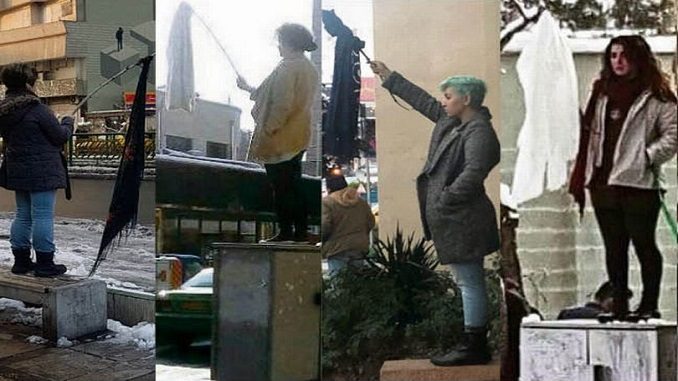
Climbing atop a five-foot-tall utility box in one of Tehran’s busiest squares on Monday, an Iranian woman removed her head scarf, tied it to a stick and waved it for all to see. It was no small feat in Iran, where women can be arrested for publicly flouting the Islamic requirement that they cover their hair, The New York Times reports.
But there she stood, her curly hair blowing in the breeze. No one protested. In fact, she was applauded by many people. Taxi drivers and older women took her picture. The police, who maintain a booth in the square, either did not see her or decided not to intervene.
“My hands were trembling, the 28-year-old said, asking not to be named out of fear of arrest. “I was anxious and feeling powerful at the same time. And proud, I felt proud.”
She was not alone. On Monday several other women, a total of six, according to social media accounts, made the same symbolic gesture: taking off their head scarves in public and waving them on a stick, emulating the young woman Vida Movahed who climbed on the same sort of utility box on Dec. 27 and was subsequently arrested. A video clip circulating on Monday purporting to show it being performed for the first time outside the capital, in the city of Isfahan.
None of the images that quickly spread over popular networks Instagram and Telegram could be independently verified. But in photographs of three women alleged to have mimicked Movahed’s protest in Tehran, the city’s current heavy snowfall is plainly in view.
A burgeoning movement is challenging the compulsory hjiab law, which requires women to cover their hair in public. It is part of a raft of social codes instituted after the 1979 Islamic Revolution that reform-minded Iranian women say are outmoded and infringe on freedom of choice.
Critics of the law had been wearing white clothing on Wednesdays for months before a dark-haired, sneaker-wearing woman stood in Tehran’s bustling Enghelab Square in late December and waved her white hijab on the end of a stick. She was arrested, and she became one of the icons of the anti-government protests that would sweep Iran a few days later. A social media campaign dubbed #Where_Is_She sprang up to demand information about her fate.
The protests, still small in number, are nevertheless significant as a rare public sign that dissatisfaction with certain Islamic laws governing personal conduct may have reached a boiling point. As the 28-year-old woman said, “I took my scarf off because I’m tired of our government telling me what to do with my body.” And some said this might just be the beginning.
“My guess is that more of these protests will follow. It’s obvious that some women want to decide for themselves what to wear,” said Nasrin Sotoudeh, a lawyer and human rights activist.
Hard-liners say that foreign intelligence agencies, including the Central Intelligence Agency, have been nurturing protests in Iran, like those that broke out in 80 cities at the end of last year. Nearly 4,000 people were arrested and 25 died, according to official statistics. The hard-liners have not provided proof to back up their claims.
While discriminatory Islamic divorce and inheritance laws pose problems for individual women, the head scarf is a highly public symbol of a set of personal rules imposed by Iran’s clerical leaders, who decide what people can wear, what music they can listen to and what television programs and movies they get to see.
Women showing their hair in public can be jailed for up to two months and fined £17.The Islamic dress code, in place since the 1979 revolution, considers veiling obligatory for any female above 13 in Iran and says they should cover themselves from head to toe while disavowing any figure-hugging dress. In late December, police said they would no longer arrest women for failing to observe the code.
The announcement signalled an easing to the strict rules and was called for by young and reform-minded Iranians who helped re-elect President Hassan Rouhani, a relative moderate, earlier this year. However, the religious police who enforce Sharia Law appear to still be taking women to task if they see them in public without their headscarf.
Many Islamists believe the hijab should not be imposed by law, although they consider it a religious task for every Muslim woman. President Rouhani and Supreme Leader Ayatollah Ali Khamenei support softer attitudes toward women with improper hijabs, although hardliners opposed to easing the rules still dominate Iran’s security forces and judiciary.
The latest protest comes after street riots earlier this month against the regime fuelled by high levels of unemployment in a country with a largely youthful and well-educated population. Many are also frustrated by the lack of social and political freedoms.
